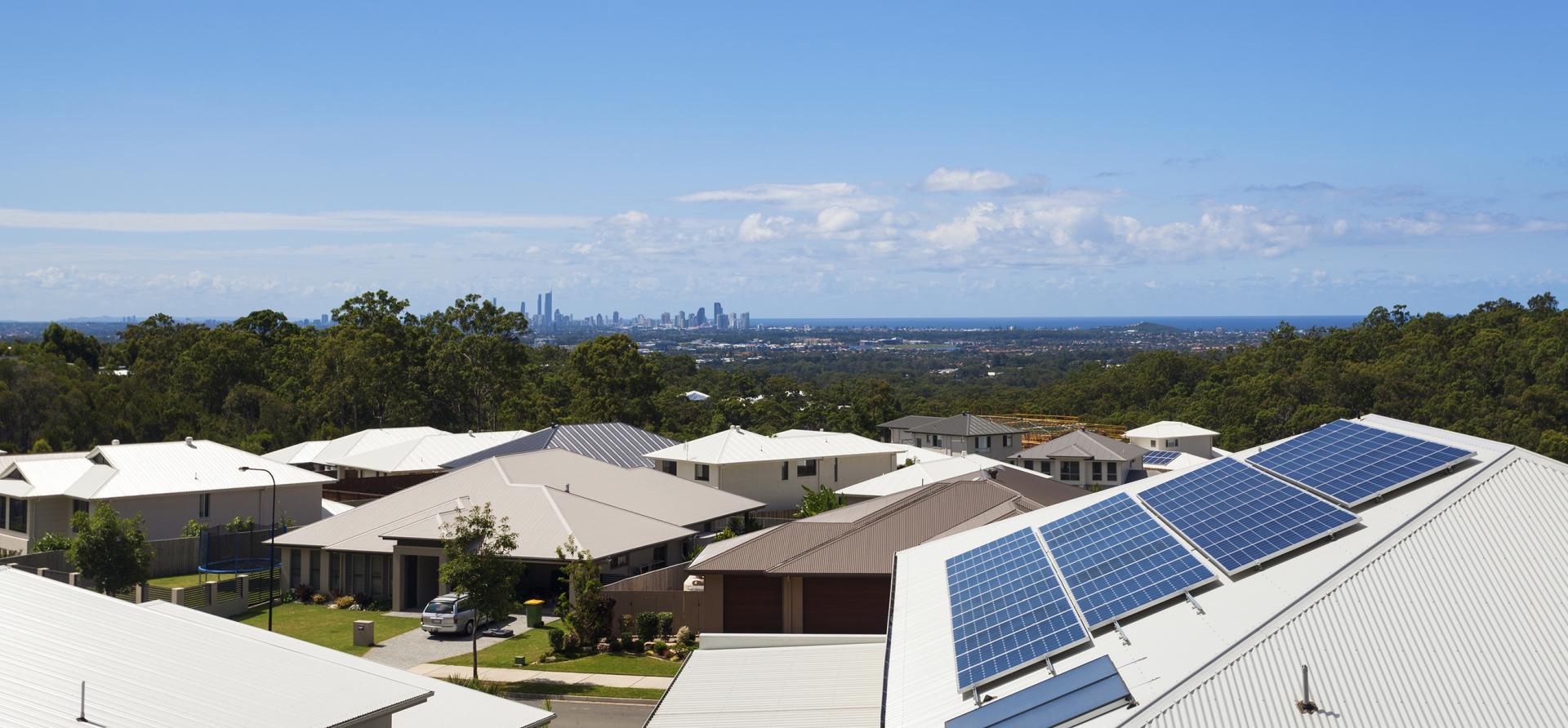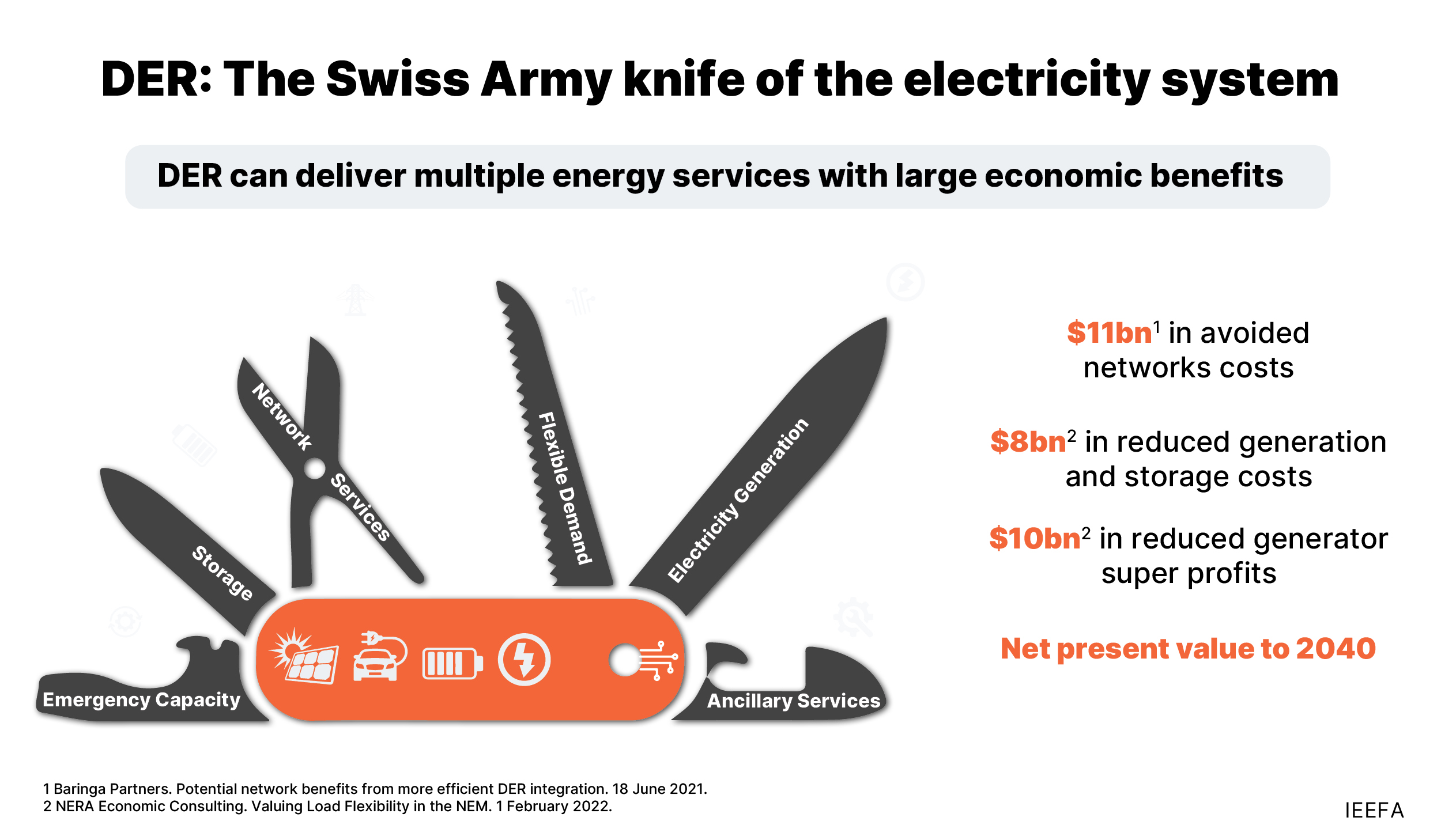
Key Findings
Distributed energy resources (DER) such as rooftop solar, electric vehicles and smart appliances could deliver economic benefits for Australia of at least $19 billion by 2040.
IEEFA conducted a meta-analysis of nine studies of DER identifying these significant economic benefits, along with a further potential consumer benefit of $10 billion in reduced generator super-profits.
Further research is required to fully understand the economic value of rooftop solar, battery storage and flexible demand.
Action is urgently needed for Australia to realise the potential of DER to help foster our economic prosperity. DER must be treated on equal terms as large-scale generation and storage in terms of policy, planning and regulation.
Executive Summary
Collectively households and businesses are driving the installation and operation of a huge number of devices that are supporting the decarbonisation of the National Electricity Market (NEM).
These distributed energy resources (DER) can reduce the amount of large-scale renewable generation needed, reduce the amount of transmission and distribution network build, provide Frequency Control Ancillary Services (FCAS), emergency power supplies (individually and through the Reliability and Emergency Reserve Trader (RERT) scheme), as well as flexible demand, including demand response. Offering such an array of possibilities, DER can be seen as the Swiss Army knife of the electricity system.

Including the likes of rooftop solar combined with stationary batteries, batteries on wheels (in other words, electric vehicles), and flexible demand (such as hot water systems), DER can respond quickly to signals to export, import or store electricity, and so can provide almost any service the grid needs. With this will come a range of economic benefits including reducing electricity system costs.
The question is: what economic contribution could DER make to the energy transition? And therefore, what value is being left on the table by not maximising the rollout and effective integration of DER? IEEFA has sought to answer these questions by conducting a meta-analysis of the available studies on the topic.
Only a handful of studies in Australia have assessed the potential economic benefits of effectively integrating DER into the electricity system, and none of them have been comprehensive. This report examines the economic modelling of both individual technologies and multiple forms of DER to understand the range of benefits and the further modelling needed to fully appreciate a DER-based electricity system.
This meta-analysis finds that, based on the results of studies by Baringa Partners and NERA Economic Consulting, DER integration could deliver a combined net present value (NPV) of more than $19 billion by 2040. The Baringa study found $11 billion in distribution and transmission network avoided costs and benefits of DER integration. Meanwhile the NERA study found $8 billion in generation and storage cost reductions resulting from high levels of DER with high flexibility. In addition, there is $10 billion in wholesale market super profit reductions which would benefit consumers, according to the NERA study.
The Baringa and NERA studies had no overlap in their modelled value streams. Summing two separate studies like this is not without risk, especially as the Baringa study is based on 2020 forecasts and does not include flexible demand more broadly or from electrification. Nonetheless, the $19 billion figure gives a sense of the magnitude of the economic benefits that could be unlocked if the energy transformation supports DER investment and integration.
Further research is needed to fully understand the economic value of rooftop solar, battery storage and flexible demand. However, despite the limited number of economic studies available, our meta-analysis reveals significant insights about the potential of DER:
- Changes to the wholesale market are likely to be highly significant. Indeed, it is likely that the “duck curve” will be put to sleep and that the 4pm-8pm evening peak will effectively disappear, transferring generators’ ‘supernormal’ profits into wholesale bill savings for consumers ($10 billion NPV by 2040 according to the NERA study) if the market operates efficiently.
- Dynamic operating envelopes (DOEs or flexible exports) are essential to realise the value of DER. In fact, the cost-benefit analysis for one trial, Project Edge, showed that $5 billion of the $6 billion in benefits (NPV to 2042) were related to the value unlocked by increasing DER exports through implementation of DOEs.
- Ensuring flexibility is vital to unlock value from electrification and to minimise the costs of the energy transition. Flexible demand is the necessary partner to variable renewable energy and as much DER as possible needs to be flexible or made flexible in the process of electrification. Policy and programs need to optimise flexibility at every possible opportunity.
- DER is not only capable of providing network services, but could save consumers at least $11 billion in NPV by 2040 according to Baringa. However, capex-bias in the existing revenue regulation is likely to prevent optimal outcomes. There is an urgent need for a first-principles review of distribution network revenue regulation. The distribution networks have a completely different role in a high-DER world to that of 20 years ago, and how they are remunerated needs to reflect this.
Our meta-analysis concludes that we need significant, courageous action on DER integration as soon as possible if we want to underpin Australia’s future economic prosperity with lower electricity and transport costs, and electrification to eliminate dependency on gas. DER must not come second in policy, planning and regulation to transmission and large-scale generation. DER must be considered on equal terms, with more thoughtful recognition of the multiple benefits outlined in this report.















